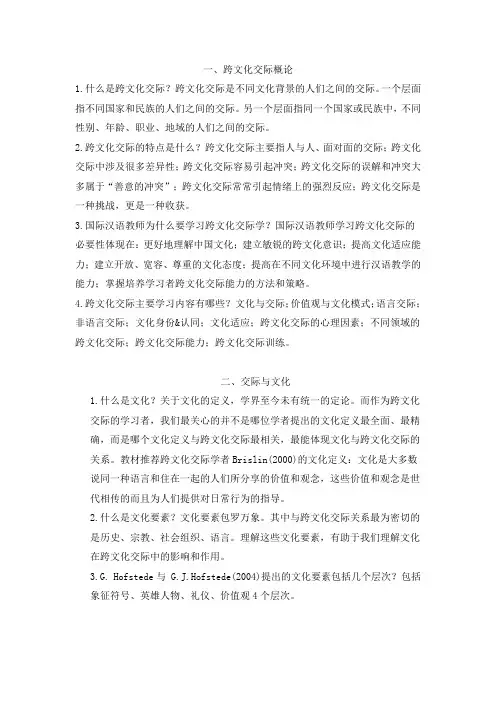跨文化交际
跨文化交际概述

国际商务谈判案例
中美贸易谈判
中美两国在贸易谈判中,由于文化背景和价值观的差异,双 方在谈判中出现了不少误解和冲突。然而,通过跨文化交际 的技巧和策略,双方最终达成了共识,实现了互利共赢的目 标。
欧盟与非洲国家的合作协议
欧盟与非洲国家在合作协议的谈判中,由于文化差异和利益 诉求的不同,双方经历了多次的沟通和协商。最终,通过跨 文化交际的努力,双方达成了多项合作协议,促进了双方的 经济和社会发展。
教育领域的跨文化交际案例
孔子学院的国际化推广
孔子学院在全球范围内的推广过程中,注重跨文化交际的应用。通过与当地文化的融合和交流,孔子学院成功地 推广了中国文化,促进了中外文化的交流和理解。
国际教育交流项目
各国高校之间的国际教育交流项目,为学生提供了跨文化交际的机会。通过参与国际教育交流项目,学生可以深 入了解不同国家的文化背景和价值观,提高跨文化交际的能力。
持续沟通
通过持续、开放的沟通,增进双方的理解与合作, 共同实现跨文化交际的成功。
04
跨文化交际的挑战与应对
语言障碍
语言差异
语言表达能力
不同文化背景的人可能使用不同的语 言或方言,导致沟通困难。
有些人可能缺乏流利的外语表达能力, 影响有效沟通。
语言理解
由于语言习惯、表达方式的不同,可 能产生误解或歧义。
跨文化交际概述
• 跨文化交际的定义与重要性 • 跨文化交际的核心概念 • 跨文化交际的技巧与策略 • 跨文化交际的挑战与应对 • 跨文化交际的案例分析
01
跨文化交际的定义与重要性
定义
跨文化交际是指来自不同文化背 景的人们之间的交流和互动。
它涵盖了语言、文化、价值观、 社会规范、信仰和习俗等方面的
跨文化交际

什么是跨文化交际跨文化交际,即本族语者与非本族语者的交际,也指任何在语言和文化背景方面有差异的人们之间的交际。
本学期通过本门课程的学习,让我学会了一下三点:一、如何正确的审视不同文化之间的差异,二、如何提高跨文化适应能力,三、如何提高跨文化的交流技能。
随着中国对外开放程度的逐渐深入,西方社会的人和事物越来越多地走进了我们的视野,在这种情况下,跨国域、跨民族、跨文化的经济和社会交往将会与日俱增,这就为我们提供了许多与西方接触和交流的机会,这对于我们加深对的西方社会的理解是一件好事,但这却并不是一件简单的事情,因为我们所面对的是陌生的国家和文化,思维方式、生活习惯和行为方式与我们迥然不同的人,在与之交往的过程中不可避免的会出现文化冲突的现象,这时在跨文化交际课堂中学到的东西便起了大用!我总结了一下中西方的差异主要集中在以下几点:一、在客观主体方面,西方人向外探索客观世界,强调真善美、爱智,注重理性科学,注重求异,科学和逻辑发现。
中国人向内探索个人世界,强调真善美、崇善,注重情感、伦理,注重求同,经验、感情。
二、在处理问题方面,西方人采取不撞南墙不回头的态度,中国人采取不可中直取,只可曲终求的态度。
不同文化背景的人们在交际时,经常出现的一个现象就是套用自身所在社会的行为规范来判定对方行为的合理性,由于双方的行为规范存在差异,常常会产生误解、不快甚至更坏的结果。
比如说中国人轻拍小孩子的头部表示一种友好,而在西方国家,这是一种极不尊重小孩子的做法,父母会对此非常愤怒。
所以说在跨文化交际中是否能够正确地识别和运用行为规范是保证跨文化交际顺利进行的重要因素。
要保障跨文化交际的顺利进行,就必须理解对方的行为规范,尤其是什么行为是被禁止的,最好的办法就是遵循入乡随俗的原则。
三、在发表个人看法时,西方人直言、直去,中国人谨言、拐弯。
四、在民族性格方面,西方人偏重功利,好走极端,与其他民族存在斗争,强调以力争天下。
中国人偏重道义,以“中庸和谐”为贵,强调协和万邦。
跨文化交际知识点汇总

一、跨文化交际概论1.什么是跨文化交际?跨文化交际是不同文化背景的人们之间的交际。
一个层面指不同国家和民族的人们之间的交际。
另一个层面指同一个国家或民族中,不同性别、年龄、职业、地域的人们之间的交际。
2.跨文化交际的特点是什么?跨文化交际主要指人与人、面对面的交际;跨文化交际中涉及很多差异性;跨文化交际容易引起冲突;跨文化交际的误解和冲突大多属于“善意的冲突”;跨文化交际常常引起情绪上的强烈反应;跨文化交际是一种挑战,更是一种收获。
3.国际汉语教师为什么要学习跨文化交际学?国际汉语教师学习跨文化交际的必要性体现在:更好地理解中国文化;建立敏锐的跨文化意识;提高文化适应能力;建立开放、宽容、尊重的文化态度;提高在不同文化环境中进行汉语教学的能力;掌握培养学习者跨文化交际能力的方法和策略。
4.跨文化交际主要学习内容有哪些?文化与交际;价值观与文化模式;语言交际;非语言交际;文化身份&认同;文化适应;跨文化交际的心理因素;不同领域的跨文化交际;跨文化交际能力;跨文化交际训练。
二、交际与文化1.什么是文化?关于文化的定义,学界至今未有统一的定论。
而作为跨文化交际的学习者,我们最关心的并不是哪位学者提出的文化定义最全面、最精确,而是哪个文化定义与跨文化交际最相关,最能体现文化与跨文化交际的关系。
教材推荐跨文化交际学者Brislin(2000)的文化定义:文化是大多数说同一种语言和住在一起的人们所分享的价值和观念,这些价值和观念是世代相传的而且为人们提供对日常行为的指导。
2.什么是文化要素?文化要素包罗万象。
其中与跨文化交际关系最为密切的是历史、宗教、社会组织、语言。
理解这些文化要素,有助于我们理解文化在跨文化交际中的影响和作用。
3.G. Hofstede与 G.J.Hofstede(2004)提出的文化要素包括几个层次?包括象征符号、英雄人物、礼仪、价值观4个层次。
4.在跨文化交际领域,常用的文化分类方法有几种?分别是什么?有两种文化分类的方法在跨文化交际领域最为常用。
如何处理跨文化交际

如何处理跨文化交际跨文化交际,指的是不同文化背景下人们之间的交流与沟通。
在如今全球化日益加速的时代,跨文化交际已成为一件不可避免的事情。
然而,由于文化差异的存在,容易产生误解、冲突,甚至导致交流失败。
因此,如何有效地处理跨文化交际,成为我们每个人都需要掌握的重要技能。
一、尊重不同的文化在进行跨文化交际时,我们首先要做的是尊重不同的文化。
不同的文化有着不同的习惯、价值观和信仰,我们应该尊重并理解这些差异。
对于一些看似奇怪或者不可理解的文化习俗,我们可以试着去了解其背后的历史文化背景以及其意义。
同时,我们也应该尊重不同文化背景下的人们所持有的观点和想法,不去质疑或者批判他人,而是尝试理解、倾听并与其保持友好的交流。
二、学会语言和文化的表达方式语言和文化是紧密相连的,学会当地的语言和文化表达方式,可以帮助我们更好的进行交流和沟通。
在学习另一种语言时,我们也要了解当地人的用词、语气、身体语言等表达方式,这有助于我们更好的理解和准确地表达自己的想法和观点。
同时,在进行跨文化交流时,我们也需要注意到不同国家和地区之间的礼仪和礼节差异。
比如,在一些国家,饮酒和抽烟是一种场合上的礼仪,而在另一些国家,则被视为不尊重他人和社交不当的行为。
三、适应不同的交际风格不同的文化有着不同的交际风格。
比如,在西方社交场合中,常常会有较强的个人色彩和自由随意的交流方式,而在亚洲国家,人们则更注重团队合作和社会秩序。
当我们面临不同的文化交际风格时,我们需要适应当地的交际环境和方式,以便更好地融入当地文化和社会。
同时,还要克制自我,尽可能避免过于个人主义或者权威的表现,以建立更好的交流和友好的关系。
四、面对文化冲突和误解在进行跨文化交际时,由于文化差异的存在,很容易产生冲突和误解。
面对这样的情况,我们应该积极寻求解决方案。
首先,我们需要尊重对方的文化和态度,试图理解其想法和观点。
同时,我们也需要耐心倾听对方的意见,试图从对方的角度去看待问题。
跨文化交际理论

跨文化交际理论一.文化、交际、跨文化交际:1.“文化”的含义:①“文化”二字最初没有联系在一起,它的意思是统治者通过观察天象,可以了解时序的变化,通过观察人类社会的各种现象,可以用教育感化的手段来治理天下。
②西方的“文化”引申出对人的性情的陶冶和品德的培养,泰勒认为,“文化”是包括知识、信仰、艺术、道德、法律、习俗和任何人作为一名社会成员而获得的能力和习惯在内的复杂整理。
③马克思主义理论家认为文化分为两种:狭义的文化指的是历史上一定的物质资料生产方式的基础上产生和发展的社会精神生活形式的总和;广义的文化指的是人类在社会历史实践过程中所创造的物质财富和精神财富的总和。
2.文化的分类:按内容分包括:物质文化、行为文化、制度文化、观念文化四个方面。
3.文化的特性:(1)文化史人类独有的,是区别人类和动物的主要标志,文化史社会遗产,而不是生理遗传。
(2)文化不是先天就有的,而是后天习得的。
(3)文化中的大部分是不自觉的,人总是自然而然地表现其文化色彩的。
(4)文化是人们行动的指南。
(5)文化是动态的,文化的形态与一定的历史时期相联系。
4.隐性文化的基本内容:包括以下内容:时间观念,对空间的利用,成就感,交际模式,对环境的取向,家庭关系,上下级关系模式,对个人的看法,对竞争和合作的偏爱,谦虚的挂念,对规章制度的需要,对宇宙的看法,法律的观念,工作积极性,对领导的看法,社交频率,友谊的性质,控制感情的模式,依据年龄、性别、阶级、职业、亲属的关系,确定地位及相关角色。
5.语言和文化的关系:①语言文化的重要组成部分,语言与文化是部分与整体的关系:一种文化不可能没有与之相应的语言;抽取文化内容,语言也不能独立存在。
②语言是用于记录文化的符号体系,是文化的主要载体。
③语言和文化相互依附、促进和制约。
6.人类交际的主要手段:符号是人们交际时使用的主要手段,任何符号都可以用来交际。
7.组成交际行为的八个重要因素:①信息源/行为源②编码③信息④渠道⑤信息接收者/反应者⑥译码⑦反应⑧反馈8.影响交际的因素:①宽泛的交际环境:包括价值观念,文化取向,宇宙观,社会结构,心理因素,物理环境因素等。
跨文化交际

从对外汉语教学看跨文化交际
• 在特定的交际情景中,具有不同的文化背景的交际者使用 同一种语言(母语或目的语)进行的口语交际。
• 交际双方必须来自不同的文化背景。立足本专业,文化差异 主要指不同文化圈之间的差异,尤其是中国和欧美国家的文 化差异。
• 交际双方必须使用同一种语言交际,不需要通过翻译这个中 间环节 。
例二
“您真是老当益壮,老骥伏枥呀!”
You are old,but nonetheless vigorous and active.So you are really an aged hero who still cherishes high aspirations.
“夕阳无限好,何愁近黄昏。”
Most glorious is the sunset.Even the dusk is blessde.
an Here’s
“大C” 和 “小C”
interesting issue
1. 文化是人们通过长时间的努力所创造出来的,是社会的遗 产;
2. 文化既包括信念、价值观念、习俗、知识等,也包括实物 和器具;
3. 文化是人们行动的指南,为人们提供解决问题的答案;
4. 文化并非生而知之,而是后天所学会的; 5. 价值观念是文化的核心,可以根据不同的价值观念区分不
文化的特性
1. 文化是人类所独有的,是区别人类和动物的主要标志。文 化是社会遗产,而不是生理的遗传。
2. 文化不是先天所有,而是通过后天习得的。 3. 文化中的大部分是不自觉的。 4. 文化是人们行动的指南。 5. 文化是动态的,文化的形态与一定的历史时期相联系。
主导文化和亚文化
主导文化:是一个民族、一个国家或一个语言群体所共享的主流文化 特征;是人们日常生活和交际中起主导作用的文化因素;是同一文化 群体共同认可和遵循的生活方式、行为规范、交际规则、思维方式和 交际观念。
跨文化交际概述
第一章跨文化交际概述第一节文化、交际和语言一关于文化的概念(一)文化的定义1.文化“文化”这个词古已有之,但他的含义与现代的理解不一样,指与“武力”相对的文德教化。
如汉代刘向《说苑·指武》中说:“圣人之治天下,先文德而后武力。
凡武之兴,为不服也;文化不改,然后加诛。
夫下愚不移,纯得之所不能化,而后武力加焉。
”又如近代束广微《补亡诗·由仪》:“文化内辑,武力外悠。
”《文选》李善注:“言以文化辑和于内,用武德加于外远也。
”后来“文化”一词被日语借入,到近代又被日语用来作为英语culture的对译词。
再后来“文化”作为日语借词又被现代汉语吸收,于是“文化”就同英语的culture有了直接的词源关系,并衍生出“文明”、“教育”等含义,文化属于人类创造的精神财富和物质财富,人性具有的共性就使得人们能共享这些财富。
然而正如孔子所说的“性相近,习相远”,人性固然相通,但“习相远”导致了文化的差异。
因此,克服文化差异所产生的障碍就显得很重要,这意味着在达到有效交际之前,我们必须了解别人的文化。
在文化学或文化人类学中,“文化”一词通常指人类社会区别于其他动物的全部活动方式以及活动的产品。
就这一概念的核心内涵而言,它的意义是明确的,然而在实际研究中,专家们给的定义却是五花八门。
美国人类学家克鲁伯(Kroeber)曾搜罗并列举了西方近现代160多位学者对“文化”所下的不同定义,并从下定义的方法角度进行了分类和研究。
在众多的关于文化的定义中,文化人类学家泰勒(Tylor)和马林诺夫斯基(Malinowski)两人的定义比较受人推崇。
泰勒认为文化“是一个复合体,包括知识、信仰、艺术、道德、法律、风俗,以及人类在社会里所获得的一切能力与习惯”马林诺夫斯基把文化看做一种具有满足人类某种生存需要的功能的“社会制度”,是“一群利用物质工具而固定生活于某一环境的人们所推行的一套有组织的风俗与活动的体系”。
前者着眼于文化的整合性和精神性,后者着眼于文化的功能性和制度性。
跨文化交际论文(3篇)
跨文化交际论文(3篇)一、关于跨文化交际的重要性随着社会的发展,全球经济一体化的形成,我国人民对于教学方式和教学内容有了新的期许,在现代社会中,想要获得成功,就需要具备良好的交际表现能力。
在跨文化的语境中所认为成功的交际是能够带来发展机会、财富以及和平的;失败的交际会使得敌对局面、偏见以及冲突产生。
在科技水平的迅猛发展中,我们正在经历的社会形势是多种多样的,如:信息化、全球化以及网络化等,不断地丰富着我们的生活。
不同文化背景的人们相互交际是一个复杂的过程,在讲外语和理解外语时都应该遵循该外语的语用规律及文化规则。
对于法语的口语教学而言,这也是一种跨文化交流的行为,语言的不同使得其表达的意识也会有差异,在法语中时常使用到的词汇用汉语解释意境就可能很大不同。
如:在法语中有着非常丰富的代词,代词用法比较复杂,因而学生在没有熟练掌握的情况下,使用法语代词会变得非常困难。
针对于您(vous)和你(tu)在法语中的用法,我们在课堂或者课后的练习中已经习惯了使用tu,随后在一些非常正式的场合也会将tu脱口而出,显然这意味着交际错误出现了。
另外,与tu所对应的动词有着简单的变位,因而学生更加喜欢在表达上使用到tu,长时间下来他们容易将语言场合忽视掉,这样错误语域的选择是外语学习中的大忌。
因此,我们需要十分的重视对学生这方面的教育,逐步将跨文化交际教学的能力加强,尽可能的将错误语境的现象减少。
如:中国自古有“爱屋及乌”的说法,法国也有着Qui m'aime,aime mon chien的说法,翻译过来就是“爱屋及狗”。
可见,中法两国巨大的文化差异,也体现在人们对于宠物的不同态度,若是学生没能够很好的掌握到、认识到这一点,就很容易发生语境错误,对于跨文化的交流非常不利。
二、培养学生跨文化法语口语交际的能力根据著名学者Gudykunst的理论,有效的跨文化交际能力应该包括基本交际能力系统、情感和关系能力系统、情节能力系统和交际方略能力系统。
跨文化交际学概论
跨文化交际学概论胡文仲第一部分绪论:跨文化交际和跨文化交际学第一章跨文化交际一、什么是跨文化交际不同文化背景的人从事交际的过程就是跨文化交际,如直接和外国人接触,阅读外国小说,看外国电影等。
跨文化交际是自古以来就有的现象,如我国汉朝的丝绸之路、佛教的传入、郑和下西洋。
L.S.Harms认为:世界范围内的交际经历了五个阶段:①语言的产生②文字的使用③印刷术的发明④近百年交通工具的进步和通讯手段的发展⑤跨文化交际。
二、对跨文化交际的不同理解Marshall Singer认为:①每个人隶属于若干群体,没有两个人隶属的群体是完全相同的;②即使在同一群体,每个人的态度、价值、信念也会完全不同;因此,每个人都是独特的,从严格意义上讲,任何人与人之间的交际都应该被视为跨文化交际。
这种观点提醒我们应该避免空泛的比较,但是,在跨文化交际研究中应该首先把眼光集中于国别研究,集中于一个国家中的主流文化的研究。
第二章跨文化交际学跨文化交际的英文:Intercultural Communication跨文化交际学首先在美国兴起。
许多学者把Eward Hall在1959年出版的《无声的语言》(The Silent Language)看作是跨文化交际学的奠基之作。
1970年国际传播学会成人跨文化交际学是传播学的一个分支,在学会下面成立了跨文化交际学分会。
1972年,第一届跨文化交际学国际会议在日本东京举行。
1974年,跨文化教育训练与研究学会(SIETAR)在美国成立,后改名为国际跨文化教育训练与研究学会。
跨文化交际学在我国大致是从80年代初期开始的。
跨文化交际学一个突出的特点是它的多学科性质,其中影响较大的是人类学、心理学、传播学。
人类学家的跨文化交际学著作:A.L.Kroeber和Clyde Kluckhohn合著的《文化概念与定义评述》是论述文化定义的经典之作。
Ruth Benedict的《菊与剑》对日本文化的模式做了深入的分析;许烺光的《美国人与中国人——通向分歧之路》对于中美文化的差异做了十分全面而透辟的分析。
跨文化交际 知识点整理
第一章.跨文化交际概论1跨文化交际汉语国际教育本质上是一种跨文化的活动。
新世纪如此广泛而深入的跨文化交际主要是受到以下因素的影响1.交通和通信技术的发展2.经济的全球化3.人口的流动4.广泛的国际交流与合作什么是跨文化交际?跨文化交际既是一种人类的社会活动,也是指一门研究跨文化交际活动的学科。
根据几个定义归纳出跨文化交际的重要特点:1.跨文化交际是不同文化背景的人们之间的交流;2.跨文化交际是通过象征符号来实现的;3.跨文化交际是一种动态的过程4.跨文化交际是一种双向的互动;5.跨文化交际的目标是创建共享的意义跨文化交际是不同文化背景的人们之间的交际,这里的跨文化交际实际上包含着两个层面一个层面是指不同国家和不同民族的人们之间的交际,例如中国人与美国人等另一个层面是指同一个国家或民族中,不同性别、年龄、职业、地域的人们之间的交际,例如男性和女性之间的交往就可以被看做是一种跨文化的交往跨文化交际的特点1.跨文化交际主要指人与人之间面对面的交流面对面的交流既包括了语言交际也包括了非语言交际,而且是一种双向交流和互动的过程2.跨文化交际中涉及很多差异性(陈国明)差异可以是文化传统、价值观、信仰等方面的差异,也涉及行为方式和习俗方面,如手势、衣着、语言使用的差异,同时也涉及个人文化身份和社会角色方面的差异。
这些存在差异的因素相互作用,影响了跨文化交流的过程和结果3.跨文化交际容易引起冲突由于语言、交际风格、非语言行为、思维模式、社会准则、价值观等方面的差异,跨文化交际很容易产生误解和冲突4.跨文化交际的误解和冲突大多属于“善意的冲突”许多冲突往往不是出于人们恶意的动机,而是来源于人们良好的愿望。
在自己文化中得体而礼貌的行为到了另一种文化中却成了无礼的举动,善良的意图却产生了意想不到的误解和不愉快5.跨文化交际常常引起情感上的强烈反应很容易造成心理紧张,人们经常提到的“文化休克”就是形容在跨文化交际中产生的心理反应。
- 1、下载文档前请自行甄别文档内容的完整性,平台不提供额外的编辑、内容补充、找答案等附加服务。
- 2、"仅部分预览"的文档,不可在线预览部分如存在完整性等问题,可反馈申请退款(可完整预览的文档不适用该条件!)。
- 3、如文档侵犯您的权益,请联系客服反馈,我们会尽快为您处理(人工客服工作时间:9:00-18:30)。
河南师范大学外国语学院考查课程答卷年级类别:2011级学科专业:学科教学(英语)学号:1105280400姓名:龙裴课程名称:跨文化交际授课教师:陈运香考试时间:考试分数:2011级教育硕士、翻译硕士“跨文化交际”测试题I.Explain the following terms.(20 points)1.Cross-cultural communication:Answer: Cross-cultural communication refers to communication between the native speakers and non-native speakers of communication, also refers to the communication among any people in different language and the background. Cross-cultural communication is a field of study that looks at how people from differing cultural backgrounds communicate, in similar and different ways among themselves, and how they endeavor to communicate across cultures.2.Enculturation:Answer: Enculturation is the process by which a person learns the requirements of the culture by which he or she is surrounded, and acquires values and behaviors that are appropriate or necessary in that culture. As part of this process, the influences which limit, direct, or shape the individual (whether deliberately or not) include parents, other adults, and peers. If successful, enculturation results in competence in the language, values and rituals of the culture. The process of enculturation is related to socialization. In some academic fields, socialization refers to the deliberate shaping of the individual, in others; the word may be used to cover both deliberate and informal enculturation.3.Perception:Answer:Perception is the means by which we make sense of our physical and social world. Our perceptions give meaning to all those external forces. Perception is the process of attaining awareness or understanding of the environment by organizing and interpreting sensory information. All perception involves signals in the nervous system, which in turn result from physical stimulation of the sense organs. For example, vision involves light striking the retinas of the eyes, smell is mediated by odor molecules and hearing involves pressure waves. Perception is not the passive receipt of these signals, but can be shaped by learning, memory and expectation. In contemporary psychology, perception is defined as the brain‟s interpretation of sensory information so as to give it meaning. Cognitive sciences make the understanding of perception more detailed: Perception is the process of acquiring, interpreting, selecting, and organizing sensory information.4.Behavioral residue:Answer: Behavioral residue refers to those things that remain as a record of our action. It implies the way we perceive people around us by the behaviors that we observe; just like the saying “The deed proves the man”. Many behaviors leave some kind of discernible residue in their wake. Given that large quantities of behavior are performed in personal environments, it makes sense that these places might accumulate a fairamount of residue.II. Answer the following questions briefly. (40 points)1.How can you understand “intercultural communication is a dynamic rather than static process”?Answer:Intercultural communication is a dynamic course during which various contextual aspects interact. To make the communication run smoothly, mutterer and interpreter should adapt their linguistic choice to the communicative context consisting of language users, psychological, linguistic, social and physical worlds. Only when the language choice adapts to linguistic and social contexts can successful communication be achieved. And, to avoid communication failures, one should know the saying- "when in Rome, do as the Romans do."Intercultural communication, in its final analysis, is a semiotic activity, dealing with sign exchanges through sign transmission in a much more complicated dynamic manner than interpersonal communication in an Intraocular. Many semiotic theories given by classic demolitions or contemporary semiotic scholars can explain intercultural communication phenomena better than those borrowed from other disciplines, at least more theoretically acceptable.2.In what ways are high-context cultures different from low-context culture?Answer: Context is the most important cultural dimension and alsoimmensely difficult to define. The idea of context in culture was an idea put forth by an anthropologist by the name of Edward T Hall. Hall breaks up culture into two main groups: High and Low context cultures. He refers to context as the stimuli, environment or ambiance surrounding the environment. Depending on how a culture relies on the three points to communicate their meaning, will place them in either High or Low context cultures. For example, Hall goes on to explain that low-context cultures assume that the individuals know very little about what they are being told, and therefore must be given a lot of background information. High-Context cultures assume the individual is knowledgeable about the subject and has to be given very little background information.3.What are collectivism and individualism? What features do they have respectively?Answer:Collectivism is defined as the theory and practice that makes some sort of group rather than the individual the fundamental unit of political, social, and economic concern. In theory, collectivists insist that the claims of groups, associations, or the state must normally supersede the claims of individuals.Individualism is the moral stance, political philosophy, ideology, or social outlook that stresses "the moral worth of the individual". Individualists promote the exercise of one's goals and desires and so value independence and self-reliance while opposing most externalinterference upon one's own interests, whether by society, family or any other group or institution.Individualism makes the individual its focus and so starts "with the fundamental premise that the human individual is of primary importance in the struggle for liberation.Features of Individualism:(1)Emphasizes independence and individual achievement(2)Promotes self-expression, individual thinking and personal choice(3)Associated with private property and individual ownership(4)Stresses competition as a means of achieving collective goals Features of Collectivism:(1)Emphasizes interdependence and group success(2)Promotes adherence to group norms, respect for authority and creating consensus(3)Associated with shared property and group ownership(4)Stresses cooperation as a means of maximizing individual achievement4.What do you think are the important factors for intercultural communication?Answer:(1) StereotypeStereotyping due to generalizing may be inevitable among those who lack frequent contact with another culture. But if you rely on the stereotypes, you will likely put yourself into an awkward and embarrassing situationand offend others.(2)EthnocentrismA consequence of this limited experience within one particular society, most people feel that their particular way of life is superior, right, and natural and that all other cultures are inferior and often wrong and unnatural. This feeling is called ethnocentrism. People everywhere develop customs and values, not to make their life more difficult or complicated, but to make life simpler and easier in their own society. We should attempt to look at other societies "within the framework of that society", instead of looking at it from the perspective of our own society.(3)Pragmatic transferTransfer is borrowed from educational psychology which is used to describe the human tendency to generalize what has been learnt in one situation to other situations.Positive transfer can help and enhance our foreign language learning while negative transfer (interference) may hinder the learning and cause breakdowns in communication.III. Please show your understanding of the following statement.(40 points)Differences exist between Chinese culture and western cultures in terms of the cultural patterns including human nature, relationship of mankind to nature, sense of time, activity and social relationship.Answer:(a)Human nature orientationChinese culture: Innately good.The orientation of being goodness is found typically in the Buddhist tradition. Buddhism maintains that we are born pure and are closest to what is called “loving kindness” when we enter this world. Chinese culture believes that people are innately good.Western culture: Innately evilWestern culture believes that people are intrinsically evil and therefore cannot be trusted seek to control the actions of their members with institutions ranging from the religious to the political. The orientation in western is based on the concept of original sin. By following some rules people can change, improve, and “be saved”.(b) Relationship of humankind to natureChinese culture:OnenessOn viewing the relationship between humankind and nature, the Chinese tend to fuse the human and 'heaven' as one part.Western culture: dividednessWestern culture is based on science, which attempts to resolve people and nature's relationship. The westerners believe that the relationship of humankind to nature is dividedness.(c) Sense of timeChinese culture: past-orientatedPast-orientated cultures believe strongly in the significance of prior events. History, established religions, and tradition are extremely important to these cultures, so there is a strong belief that the past should be the guide for making decisions and determining truth. One typical past orientation is in China.Western culture: future-orientationFuture-orientation cultures emphasize the future and expect it to be grander and nicer than the present. What is coming next holds the greatest attraction for them. The United States is considered to be such kind. Most Americans are believed to be always planning for the future instead of experiencing the moment. In fact, American‟s vi ew of the future makes them optimistic, which is reflected in the proverb: “If at first you don‟t succeed, try, try, and try again.”(d) ActivityChinese culture: BeingBeing orientation refers to spontaneous activity. Such cultures hold the view that the current activity is the one that matters most and believe that the act of …being‟ is one of the main goals and joys of life.Western culture: DoingDoing orientation describes activity in which accomplishments are measurable by standards external to the acting agent, that is, thisorientation thrives on action. E.g. “No sooner said than done—so acts your man of worth”, “Idle hands are the devil‟s workshop.”(e) Social relationshipChinese culture: Collectivism and Group-orientedCollectivism is characterized by a rigid social framework that distinguishes between in-groups and out-groups. People count on their in-group (relatives, clans, organizations) to look after them, and in exchange for that they believe they owe absolute loyalty to the group. A culture based on masses. People placed country and family above your own self. Chinese uses ethics and tolerance to resolve people and people's relationship,Western culture: Individualism and Ego-centrismWestern culture is based on individualism rather than on mass (collectivism). For instance, in the US, you always talk about individual rights, instead of placing the whole society above your own self. This is clearly different in China where a country, society or families are placed above your own self.。
